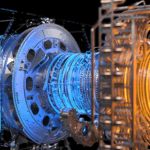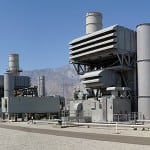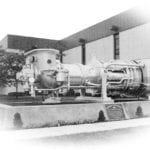As variable generation from wind and solar power increases and peak loads grow and become more volatile, the U.S. electric grid will rely more and more on gas-fired power to maintain system flexibility. Often at the core of these gas-fired power plants are aeroderivative turbines, whose fast-start and cycling capabilities allow for frequent on-again, off-again operation while retaining generating efficiency.
These turbines are directly derived from jet engines—hence the name, “aeroderivative.” GE, Pratt & Whitney, and Rolls Royce are the three major manufacturers of aeroderivative gas turbines, and each of their models is descendant from a specific aircraft engine they previously developed. As a result, aircraft engine research and development (R&D) has effectively served as aeroderivative gas turbine R&D. The development and tremendous gains in performance in these turbines are largely due U.S. military investment—as illustrated in the latest case study from the American Energy Innovation Council’s series on the role of the government in energy technology innovation and previewed in this article.
Decades of Public Investment
During and after World War II, the United States invested heavily in jet engine development. Initially, the U.S. military spurred jet engine development through competitive procurement among GE, Pratt & Whitney, and Westinghouse. The three U.S. companies competed to produce superior jet engine technology, each developing different engineering approaches that provided useful advances in turbine compressors. Over the course of the 1950s, GE and Pratt & Whitney established themselves as the most skilled manufacturers in the field, with Westinghouse eventually winding down its jet engine division. To this day, GE and Pratt & Whitney remain dominant in the aircraft gas turbine market, largely owing to years of accumulated expertise from military contracts.
Early efforts to meet military demands resulted in innovative jet engine designs, like the Pratt & Whitney J-57 and the GE J-79. However, the U.S. military incurred a substantial cost in funding their development. Moreover, these jet engine technologies did not behave reliably, and, owing to a lack of understanding of the gas turbines’ physical properties, the engineers at these companies ultimately proceeded through costly trial and error. In the 1960s, the Air Force Propulsion Lab began working directly with GE and Pratt & Whitney to jointly manage jet engine research and development, focusing on improving core components individually rather than constructing and testing complete engines. The shift to a “building block” approach proved timely for the industry, which began adapting components validated for military aviation to the emerging market of commercial aviation.
Around the same time, the U.S. Navy began transitioning its fleet from steam to gas turbines. The unique operating conditions of naval propulsion, such as using non-aviation fuels and exposure to high-salinity conditions, meant that adaptation of jet engines would require further research and development. In the late 1960s, the Navy implemented extensive side-by-side testing of GE and Pratt & Whitney aeroderivative turbines, generating a wealth of knowledge about materials engineering that enabled the adaptation of aeroderivative turbines to harsher service environments, including oil and gas pumping operations.
New And Unforeseen Applications
As a result of these public investments in aircraft gas turbine development, GE and Pratt & Whitney accumulated immense expertise and soon adapted their designs to industrial applications, which other companies learned from. Pipeline operators adopted aeroderivative turbines because they were easier to transport, install, and maintain in remote locations. Offshore oil platforms utilized aeroderivative turbines for their small footprint and high power output. Following a series of blackouts in the 1960s, utilities in the U.S. and Europe installed aeroderivative turbines for handling emergencies and periods of peak electricity demand because of their ability to ramp up more quickly than other industrial gas turbines. After the natural gas utility deregulation in the 1970s and 80s, independent power producers began using aeroderivatives for combined heat and power applications. At the same time, the industry enhanced its larger industrial gas turbines with engineering tools originally developed for building aircraft engines.
Presently, turbine manufacturers continue to improve aeroderivative gas turbines, speeding up their start-up times, increasing their efficiency, and expanding their capacity. For example, GE now builds a gas turbine that couples an aeroderivative core with larger, frame-type turbine components in a unit rated at 100 MW, a capacity far greater than that of conventional aeroderivatives. Moreover, aeroderivatives are starting to be paired with larger frame type industrial turbines in flexible combined-cycle generating units, which merge the advantages of simple cycle speed with the efficiency of a combined-cycle system. With power generation from natural gas and variable renewable sources on the rise, there is an ever-growing demand for the flexibility that aeroderivative gas turbines offer.
Lessons for Energy R&D
What lessons can we learn from this history? U.S. military procurement not only established the business case for private R&D efforts, but also established a deep, mission-driven partnership that guided those R&D efforts. The U.S. military did not “invent” anything, but rather served as an instigator and a catalyst for private sector activity. Government contracts with private firms and sharing of engineering knowledge between the military and industry increased the capacities of these firms such that they could rapidly innovate and go on to supply commercial aviation, pipeline operations, and electricity generation needs. None of these applications were planned or even foreseen. And U.S. companies remain dominant in the global aeroderivative turbine market, building on their first-mover advantages established long ago.
Gas turbine innovation was neither easy nor straightforward. Philip Scranton, a historian of jet engines, observed:
“Viewed from a distance, the development of jet propulsion in the U.S. may appear to have been a chronicle of progress through skillful management of technology and organization. Examined closely, it stands rather as a shining example of non-linear, irrational, uncertain, multi-lateral, and profoundly passionate technological and business practice, yielding success not through planning but through dogged determination, a certain indifference to failure (which secrecy aided), and massive expenditures of public funds.” (emphasis added)
Military imperatives drove jet engine development. Energy technology innovation in the U.S. is unlikely to elicit any similar “massive expenditures of public funds” or “indifference to failure,” absent broad political agreement on its importance. It is difficult to imagine.
Nevertheless, the case of aeroderivative gas turbines is instructive of the role that U.S. public investment has historically played in many major energy technologies. Private sector firms were directly responsible for evolving their operations, identifying new opportunities, and driving the energy technology innovation. By procuring the initial technology, the government created a market that did not previously exist and instigated private sector R&D efforts. By supplementing contracts with shared engineering expertise and testing protocols, the government catalyzed the innovation efforts of the private sector. Ultimately, these twin roles are repeated again and again in other cases—which you can read at the American Energy Innovation Council’s website.
—Jason Burwen is a senior policy analyst with the Bipartisan Policy Center. This article was previously published on the Energy Collective, with minor style edits for this publication.










